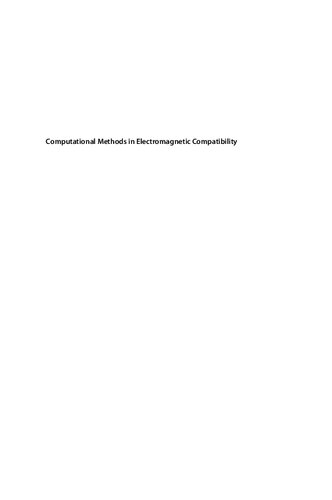

Most ebook files are in PDF format, so you can easily read them using various software such as Foxit Reader or directly on the Google Chrome browser.
Some ebook files are released by publishers in other formats such as .awz, .mobi, .epub, .fb2, etc. You may need to install specific software to read these formats on mobile/PC, such as Calibre.
Please read the tutorial at this link: https://ebookbell.com/faq
We offer FREE conversion to the popular formats you request; however, this may take some time. Therefore, right after payment, please email us, and we will try to provide the service as quickly as possible.
For some exceptional file formats or broken links (if any), please refrain from opening any disputes. Instead, email us first, and we will try to assist within a maximum of 6 hours.
EbookBell Team

4.8
84 reviewsOffers a comprehensive overview of the recent advances in the area of computational electromagnetics
Computational Method in Electromagnetic Compatibility offers a review of the most recent advances in computational electromagnetics. The authors—noted experts in the field—examine similar problems by taking different approaches related to antenna theory models and transmission line methods. They discuss various solution methods related to boundary integral equation techniques and finite difference techniques.
The topics covered are related to realistic antenna systems including antennas for air traffic control or ground penetrating radar antennas; grounding systems (such as grounding systems for wind turbines); biomedical applications of electromagnetic fields (such as transcranial magnetic stimulation); and much more. The text features a number of illustrative computational examples and a reference list at the end of each chapter. The book is grounded in a rigorous theoretical approach and offers mathematical details of the formulations and solution methods. This important text:
Written for engineering students, senior researchers and practicing electrical engineers, Computational Method in Electromagnetic Compatibility provides a valuable resource in the design of equipment working in a common electromagnetic environment.
Review:
Great on Maths, Low on Practical ApplicationsReviewed in the United States on 23 November 2019 Verified Purchase
The book has a promising title for the practicing EMI/EMC engineer, however, it is mathematically intensive. The practicing EMI/EMC engineer will benefit from the general descriptions about Maxwell's equations, coupling to buried lines, and lightning coupling to structures such as wind mills. This book was written for academics, not practicing EMIEMC engineers who are looking for practical computational methods.